Is Voluntary Product Stewardship for E-Waste Working in New Zealand? A Whangarei Case Study
Abstract
1. Introduction
1.1. The New Zealand E-Waste Scape
1.2. Whangarei Case Study
2. Methods
3. Results
3.1. General Recycling Behaviours and Values
3.2. E-Waste Behaviours–Quantitative Results
3.3. E-Waste Behaviours–Qualitative Results
3.4. E-Waste Management
4. Discussion
4.1. Influences on E-Waste Behaviours
4.2. E-Waste Services and Cost
4.3. Obsolescence and Its Impact on Volume
4.4. Would Mandatory EPR Increase Recycling Rates?
5. Conclusions
Author Contributions
Funding
Conflicts of Interest
Appendix A
| Question(s) |
| PART ONE: DEMOGRAPHICS |
| 1. Which area of Whangarei do you live in? |
| 2. Which age group do you fit into? |
| 3. Are you: male/female/other |
| 4. Which ethnic group(s) do you belong to? |
| 5. Who lives in your household? |
| 6. What is your highest completed qualification? (e.g., trade certificate, bachelor’s degree, etc.) |
| 7. What is your household income? |
| 8. Which political party do you support? |
| PART TWO: GENERAL RECYCLING BEHAVIOURS |
| 9. How often do you recycle the following household waste items? (Glass, Plastic, Metal, Aluminium, Paper, Cardboard) |
| PART TWO: ENVIRONMENTAL BELIEFS |
| 10. Please rate whether you agree with the following statements relating to household waste management. (Recycling substantially reduces the use of landfills; Recycling conserves natural resources; Recycling will not make much difference to the quality of the environment; Recycling creates jobs; Households like mine should not be blamed for environmental problems caused by excessive waste generation; Given increasing environmental problems with waste, I feel a moral obligation to recycle; E-waste creates significant environmental and social problems; Storing electronic equipment at the end of its useful life has a significant environmental impact). |
| PART THREE: E-WASTE BEHAVIOURS |
| 11. Why might you dispose of the following types of e-waste? |
| 12. How do you currently dispose of [11 WEEE categories of e-waste] in your household? |
| 13. If you stated that your household stores e-waste on the previous page, please indicate what type of e-waste you currently have in storage, and how many items. |
| 14. If you stated that your household stores e-waste, please rate the following statements for your household. |
| 15. I would change the way that I/we manage e-waste in my/our household if... |
| 16. When was the last time you disposed of e-waste? And how did you do it? |
| PART FOUR: E-WASTE MANAGEMENT |
| 17. Are you satisfied with the effectiveness of e-waste recycling services available in your community? |
| 18. Do you know where the nearest waste transfer station is to your home? And have you used it to dispose of e-waste? |
| 19. If consumers are expected to pay for user friendly, quality assured, environmentally sound, healthy and safe e-waste recycling, how much would you be willing to pay? |
| 20. How would you rate the ‘overall effectiveness’ of the current approach in dealing with e-waste in New Zealand as a whole? |
| 21. In your opinion, what is the best approach for New Zealand in dealing with e-waste issues? |
References
- Jaiswal, A.; Samuel, C.; Patel, B.S.; Kumar, M. Go green with WEEE: Eco-friendly approach for handling e-waste. Procedia Comput. Sci. 2015, 46, 1317–1324. [Google Scholar] [CrossRef]
- Kiddee, P.; Naidu, R.; Wong, M.H. Electronic waste management approaches: An overview. Waste Manag. 2013, 33, 1237–1250. [Google Scholar] [CrossRef] [PubMed]
- Baldé, C.P.; Forti, V.; Gray, V.; Kuehr, R.; Stegmann, P. Quantities, Flows, and Resources the Global E-Waste Monitor 2017; United Nations University: Tokyo, Japan, 2017; Available online: https://www.itu.int/en/ITU-D/Climate-Change/Documents/GEM%202017/Global-E-waste%20Monitor%202017%20.pdf (accessed on 27 May 2019).
- Cucchiella, F.; D’Adamo, I.; Lenny Koh, S.C.; Rosa, P. Recycling of WEEEs: An economic assessment of present and future e-waste streams. Renew. Sustain. Energy Rev. 2015, 51, 263–272. [Google Scholar] [CrossRef]
- Baldé, C.P.; Wang, F.; Kuehr, R.; Huisman, J. The Global E-Waste Monitor 2014; United Nations University: Bonn, Germany, 2015. [Google Scholar]
- Marvropoloulos, A.; Newman, D. Wasted Health: The Tragic Case of Dumpsites; ISWA: Vienna, Austria, 2015; Available online: https://www.iswa.org/fileadmin/galleries/Task_Forces/THE_TRAGIC_CASE_OF_DUMPSITES.pdf (accessed on 27 May 2019).
- Robinson, B.H. E-waste: An assessment of global production and environmental impacts. Sci. Total Environ. 2009, 408, 183–191. [Google Scholar] [CrossRef]
- Wilson, D.C.; Rodic, L.; Modak, P.; Soos, R.; Carpintero, A.; Velis, C.; Iyer, M.; Simonett, O. Global Waste Management Outlook: Summary For Decision-Makers; ISWA and UNEP: Vienna, Austria, 2015. [Google Scholar]
- Ministry for the Environment. Briefing to the Incoming Minister for the Environment: ‘Environment Portfolio’; Ministry for the Environment: Wellington, New Zealand, 2017. Available online: https://www.mfe.govt.nz/sites/default/files/media/final-bim-release-environment-portfolio-dec-2017.pdf (accessed on 27 May 2019).
- Ministry for the Environment. Review of the Effectiveness of the Waste Disposal Levy 2017; Ministry for the Environment: Wellington, New Zealand, 2017. Available online: http://www.mfe.govt.nz/sites/default/files/media/Waste/Review-of-the-effectiveness-of-the-waste-disposal-levy-2017.pdf (accessed on 27 May 2019).
- SLR Consulting NZ Limited. E-Waste Product Stewardship Framework for New Zealand Final Report; Ministry for the Environment: Wellington, New Zealand, 2015. Available online: http://www.mfe.govt.nz/sites/default/files/media/Waste/e-waste-product-stewardship-framework.pdf (accessed on 27 May 2019).
- Population—Stats NZ. Available online: https://www.stats.govt.nz/topics/population (accessed on 20 March 2019).
- Gertsakis, J.; Hannon, J.; MacGibbon, J.; Nixon, C.; Tripathi, N.; Wilkinson, S.; Zwimpfer, L. e-Waste in New Zealand: Five Years on; Ministry for the Environment: Wellington, New Zealand, 2012. Available online: http://www.eday.org.nz/template/ewaste_in_nz_2011_final2.pdf (accessed on 27 May 2019).
- MacGibbon, J.; Zwimpfer, L. e-Waste in New Zealand: Taking Responsiblity for End of Life Computers and TVs; Ministry for the Environment: Wellington, New Zealand, 2006. Available online: http://www.eday.org.nz/template/e-waste_in_nz_report_final_050706_medium_res.pdf + (accessed on 27 May 2019).
- Nixon, C. The Economics of e-Waste: Evaluation of Regulatory Options; NZIER & eDay NZ Trust: Wellington, New Zealand, 2011. [Google Scholar]
- Ministry for the Environment. Waste Minimisation in New Zealand: Summary of Submissions; Ministry for the Environment: Wellington, New Zealand, 2010. Available online: http://www.mfe.govt.nz/publications/waste/waste-minimisation-summary-submissions/index.html (accessed on 27 May 2019).
- Ministry for the Environment. Priority Waste Streams for Product Stewardship Intervention: Summary of Submissions; Ministry for the Environment: Wellington, New Zealand, 2015. Available online: http://www.mfe.govt.nz/publications/waste/priority-waste-streams-product-stewardship-intervention-summary-submissions (accessed on 27 May 2019).
- Kaye-Blake, B.; Nixon, C.; Byett, A.; Cocks, J. Willingness to Pay for Six End-Of-Life Products: NZIER Report to Ministry for the Environment; Ministry for the Environment: Wellington, New Zealand, 2013. Available online: http://www.mfe.govt.nz/sites/default/files/media/Waste/willingness-to-pay-final.pdf (accessed on 27 May 2019).
- Parliament of New Zealand. Waste Minimisation Act 2008, (January), 51. Available online: http://www.legislation.govt.nz/act/public/2008/0089/latest/DLM999802.html (accessed on 27 May 2019).
- Farrelly, T.; Tucker, C. Action research and residential waste minimisation in Palmerston North, New Zealand. Resour. Conserv. Recycl. 2014, 91, 11–26. [Google Scholar] [CrossRef]
- Hannon, J. A Multi-Stakeholder Examination of Ewaste Issues and Opportunities in New Zealand; Massey University: Palmerston North, New Zealand, 2014; unpublished manuscript. [Google Scholar]
- Mobile Phone Appeal. Available online: https://www.starship.org.nz/foundation/fundraising/mobile-phone-appeal/ (accessed on 12 May 2019).
- Re:Mobile—Mobile Phone Recycling Programme. Available online: http://www.remobile.org.nz/ (accessed on 12 May 2019).
- Mobile Trade-In. Available online: https://www.spark.co.nz/help/other/terms/retired-terms/tradeintradeuptermsandconditions/ (accessed on 18 May 2019).
- Vodafone Trade-In. Available online: http://tradein.vodafone.co.nz/ (accessed on 18 May 2019).
- Trade-In Terms and Conditions. Available online: https://www.2degreesmobile.co.nz/termsofuse/mobile/extra-services/trade-in-terms-and-conditions/ (accessed on 18 May 2019).
- Rubbish—Whangarei District Council. Available online: http://www.wdc.govt.nz/WaterandWaste/Rubbish/Pages/default.aspx (accessed on 20 March 2019).
- Sustainability. Available online: https://www.fisherpaykel.com/nz/company/sustainability.html (accessed on 19 May 2019).
- New Zealand among Most Wasteful Countries in Developed World—World Bank. Available online: https://www.newshub.co.nz/home/new-zealand/2018/01/new-zealand-among-most-wasteful-countries-in-developed-world-world-bank.html (accessed on 18 May 2019).
- International Environmental Agreements. Available online: http://www.mfe.govt.nz/more/international-environmental-agreements (accessed on 12 May 2019).
- New Zealand Product Stewardship Council. Available online: https://www.nzpsc.nz/ (accessed on 19 May 2019).
- Ministry for the Environment. Waste Minimisation in New Zealand: A Discussion Document from the Ministry for the Environment; Ministry for the Environment: Wellington, New Zealand, 2009. Available online: http://www.mfe.govt.nz/sites/default/files/waste-minimisation-discussion-document.pdf (accessed on 27 May 2019).
- OECD Environmental Performance Reviews: New Zealand 2017. Available online: https://www.oecd.org/newzealand/oecd-environmental-performance-reviews-new-zealand-2017-9789264268203-en.htm (accessed on 12 May 2019).
- Speech to Green Party 2018 AGM—Eugenie Sage, Associate Environment Minister. Available online: https://www.greens.org.nz/news/speech/speech-green-party-2018-agm-eugenie-sage-associate-environment-minister (accessed on 12 May 2019).
- Computer Access NZ Trust (CANZ). Available online: http://www.canz.org.nz/ (accessed on 27 May 2019).
- Hoeveler, J.-A. International approaches to dealing with electronic waste. N. Z. J. Environ. Law 2009, 13, 117–160. [Google Scholar]
- TV Takeback WasteMINZ Presentation. Available online: https://www.wasteminz.org.nz/wp-content/uploads/TV-TakeBack.pdf (accessed on 12 May 2019).
- $1m for Electronic Waste Scheme. Available online: http://www.radionz.co.nz/news/national/82225/$1m-for-electronic-waste-scheme (accessed on 12 May 2019).
- Whangarei District Council. Demographic profile of the Whangarei District. 2013. Available online: http://www.wdc.govt.nz/PlansPoliciesandBylaws/Plans/SustainableFutures/Documents/Sustainable Society and Culture/Demographic-Profile-of-the-Whangarei-District.pdf (accessed on 27 May 2019).
- Darby, L.; Obara, L. Household recycling behaviour and attitudes towards the disposal of small electrical and electronic equipment. Resour. Conserv. Recycl. 2005, 44, 17–35. [Google Scholar] [CrossRef]
- Dwivedy, M.; Mittal, R.K. Willingness of residents to participate in e-waste recycling in India. Environ. Dev. 2013, 6, 48–68. [Google Scholar] [CrossRef]
- Barr, S.; Ford, N.J.; Gilg, A.W. Attitudes towards recycling household waste in Exeter, Devon: Quantitative and qualitative approaches. Local Environ. 2003, 8, 407–421. [Google Scholar] [CrossRef]
- Ansari, N.L.; Ashraf, M.; Malik, B.T.; Grunfeld, H. Green IT awareness and practices: Results from a field study on mobile phone related e-waste in Bangladesh. In Proceedings of the International Symposium on Technology and Society, Wollongong, Australia, 7–9 June 2010; Available online: https://www.researchgate.net/publication/224158109_Green_IT_awareness_and_practices_Results_from_a_field_study_on_mobile_phone_related_e-waste_in_Bangladesh (accessed on 27 May 2019).
- Nixon, H.; Saphores, J.-D.M.; Ogunseitan, O.A.; Shapiro, A.A. Understanding preferences for recycling electronic waste in California: The influence of environmental attitudes and beliefs on willingness to pay. Environ. Behav. 2008, 41, 101–124. [Google Scholar] [CrossRef]
- Rea, L.M.; Parker, R.A. Designing and Conducting Survey Research: A Comprehensive Guide, 3rd ed.; John Wiley & Sons: San Francisco, CA, USA, 2005. [Google Scholar]
- 2013 Census Quickstats about Whangarei District. Available online: http://archive.stats.govt.nz/Census/2013-census/profile-and-summary-reports/quickstats-about-a-place.aspx?url=%2FCensus%2F2013-census%2Fprofile-and-summary-reports%2Fquickstats-about-a-place.aspx&request_value=13108&tabname=&sc_device=pdf (accessed on 27 April 2019).
- Hunter, L.M.; Hatch, A.; Johnson, A. Cross-national gender variation in environmental behaviors. Soc. Sci. Q. 2004, 85, 677–694. [Google Scholar] [CrossRef]
- Martin, M.; Williams, I.D.D.; Clark, M. Social, cultural and structural influences on household waste recycling: A case study. Resour. Conserv. Recycl. 2006, 48, 357–395. [Google Scholar] [CrossRef]
- Dudovskiy, J. Convenience Sampling. 2018. Available online: https://research-methodology.net/sampling-in-primary-data-collection/convenience-sampling/ (accessed on 27 May 2019).
- Creswell, J.W.; Miller, D.L. Determining validity in qualitative inquiry. Theory Pract. 2000, 39, 124–130. [Google Scholar] [CrossRef]
- Triola, M.F. Elementary Statistics Using Excel, 5th ed.; Pearson Education Limited: Essex, UK, 2014. [Google Scholar]
- Saphores, J.D.M.; Ogunseitan, O.A.; Shapiro, A.A. Willingness to engage in a pro-environmental behavior: An analysis of e-waste recycling based on a national survey of U.S. households. Resources. Conserv. Recycl. 2012, 60, 49–63. [Google Scholar] [CrossRef]
- Smith, W.G. Does Gender Influence Online Survey Participation? A Record-Linkage Analysis of University Faculty Online Survey Response Behavior; San Jose State University: San Jose, CA, USA, 2008; Available online: https://files.eric.ed.gov/fulltext/ED501717.pdf (accessed on 27 May 2019).
- Neumayer, Eric. The Environment, Left-Wing Political Orientation and Ecological Economics. 2004. Available online: https://www.researchgate.net/publication/292047385_The_environment_left-wing_political_orientation_and_ecological_economics (accessed on 27 May 2019).
- Final Results—New Zealand 2017 General Election. Available online: https://interactives.stuff.co.nz/NZ-election-home/ (accessed on 21 June 2018).
- Recycling—Whangarei District Council. Available online: http://www.wdc.govt.nz/WaterandWaste/Rubbish/Pages/Recycling.aspx (accessed on 3 April 2019).
- Directive 2012/19/Eu of the European Parliament and of the Council of 4 July 2012 on Waste Electrical and Electronic Equipment (WEEE) European Union. Available online: http://data.europa.eu/eli/dir/2012/19/oj (accessed on 27 May 2019).
- Rice, J.L. An urban political ecology of climate change governance. Geogr. Compass 2014, 8, 381–394. [Google Scholar] [CrossRef]
- Fahy, F.; Davies, A. Home improvements: Household waste minimisation and action research. Resour. Conserv. Recycl. 2007, 52, 13–27. [Google Scholar] [CrossRef]
- Blake, J. Overcoming the ‘value-action gap’ in environmental policy: Tensions between national policy and local experience. Local Environ. 1999, 4, 257–278. [Google Scholar] [CrossRef]
- Tonglet, M.; Phillips, P.S.; Bates, M.P. Determining the drivers for householder pro-environmental behaviour: Waste minimisation compared to recycling. Resour. Conserv. Recycl. 2004, 42, 27–48. [Google Scholar] [CrossRef]
- Murugesan, S. Harnessing Green IT: Principles and Practices. IT Prof. 2008, 10, 24–33. [Google Scholar] [CrossRef]
- Un-Backed Body ‘Right’ to Single Out New Zealand as an E-Waste Laggard. Available online: https://www.stuff.co.nz/business/industries/99848483/unbacked-body-singles-out-new-zealand-as-an-ewaste-laggard (accessed on 30 April 2019).
- Whangarei District Council. Personal Communication; Whangarei District Council: Whangarei District, New Zealand, 2018. [Google Scholar]
- Measuring New Zealand’s Progress Using a Sustainable Development Approach. Available online: http://archive.stats.govt.nz/browse_for_stats/snapshots-of-nz/Measuring-NZprogress-sustainable-dev-approach/sustainable-development/waste.aspx (accessed on 30 October 2018).
- Slade, G. Made to Break: Technology And Obsolescence in America; Harvard University Press: Cambridge, MA, USA, 2006. [Google Scholar]
- Braungart, M.; McDonough, W. Cradle to Cradle: Re-Making the Way We Make Things; Johnathan Cape: London, UK, 2008. [Google Scholar]
- Liboiron, M. Tactics of Waste, Dirt and Discard in the Occupy Movement. Soc. Mov. Stud. 2012, 11, 393–401. [Google Scholar] [CrossRef]
- Hallows, D.; Munnik, V. Wasting the Nation: Making Trash of People and Places; Groundwork: Petermaritzburg, South Africa, 2008. [Google Scholar]
- Webb, B.; Marshall, B.; Czarnomski, S.; Tilley, N. Fly-Tipping: Causes, Incentives and Solutions; UCL Jill Dando Institute: London, UK, 2006; Available online: http://www.tacklingflytipping.com/Documents/NFTPG-Files/Jill-Dando-report-flytipping-research-report.pdf (accessed on 27 May 2019).
- Gurauskienė, I. The behaviour of consumers as one of the most important factors in e-waste problem. Environmental Res. Eng. Manage. ISSN 2008, 4, 56–65. Available online: https://www.researchgate.net/publication/229015608_The_Behaviour_of_Consumers_as_One_of_the_Most_Important_Factors_in_E-waste_Problem (accessed on 27 May 2019).
- Enkvist, P.A.; Klevnas, P. The Circular Economy—A Powerful Force for Climate Mitigation: Transformative Innovation for Prosperous and Low-Carbon Industry; Material Economics Sverige AB: Stockholm, Sweden, 2018; Available online: https://www.sitra.fi/en/publications/circular-economy-powerful-force-climate-mitigation/ (accessed on 27 May 2019).
- Ellen MacArthur Foundation. Towards the Circular Economy: Economic and Business Rationale for an Accelerated Transition; Executive Summary; Ellen MacArthur Foundation: Cowes, Isle of Wright, UK, 2012; Available online: http://www.ellenmacarthurfoundation.org/business/reports (accessed on 27 May 2019).
- Griffin, J.; Jones, P.; Brosnahan, E.; McGlennon, S.; Kenworthy, A.; Stephenson, F.; Tomashek, M. The Circular Economy Opportunity for Auckland and How Business Can Realise it; SBN-NZ: Auckland, New Zealand, 2017; Available online: https://static1.squarespace.com/static/59d8312f268b96ed79bdadc3/t/5af25e570e2e729b66cb31ea/1525833380771/SBN_CircularEconomyOpportunity_ForAuckland.pdf (accessed on 27 May 2019).
- 2016 EPR Summary Report. Available online: http://www.eprcanada.ca/reports/2016/EPR-Report-Card-2016.pdf (accessed on 27 April 2019).
- Peterson, D.P. Effective Product Stewardship Models: A look at the Overseas Evidence. Presented at the WasteMINZ Conference, Wellington, New Zealand, 30 October 2014. Available online: https://www.wasteminz.org.nz/pubs/effective-product-stewardship-modelsa-look-at-the-overseas-evidence/ (accessed on 27 May 2019).
- Kollmuss, A.; Agyeman, J. Mind the Gap: Why do people behave environmentally and what are the barriers to pro-environmental behaviour. Environ. Educ. Res. 2002, 8, 239–260. [Google Scholar] [CrossRef]
- Middlemiss, L. Reframing individual responsibility for sustainable consumption: Lessons from environmental justice and ecological citizenship. Environ. Values 2010, 19, 147–167. [Google Scholar] [CrossRef]
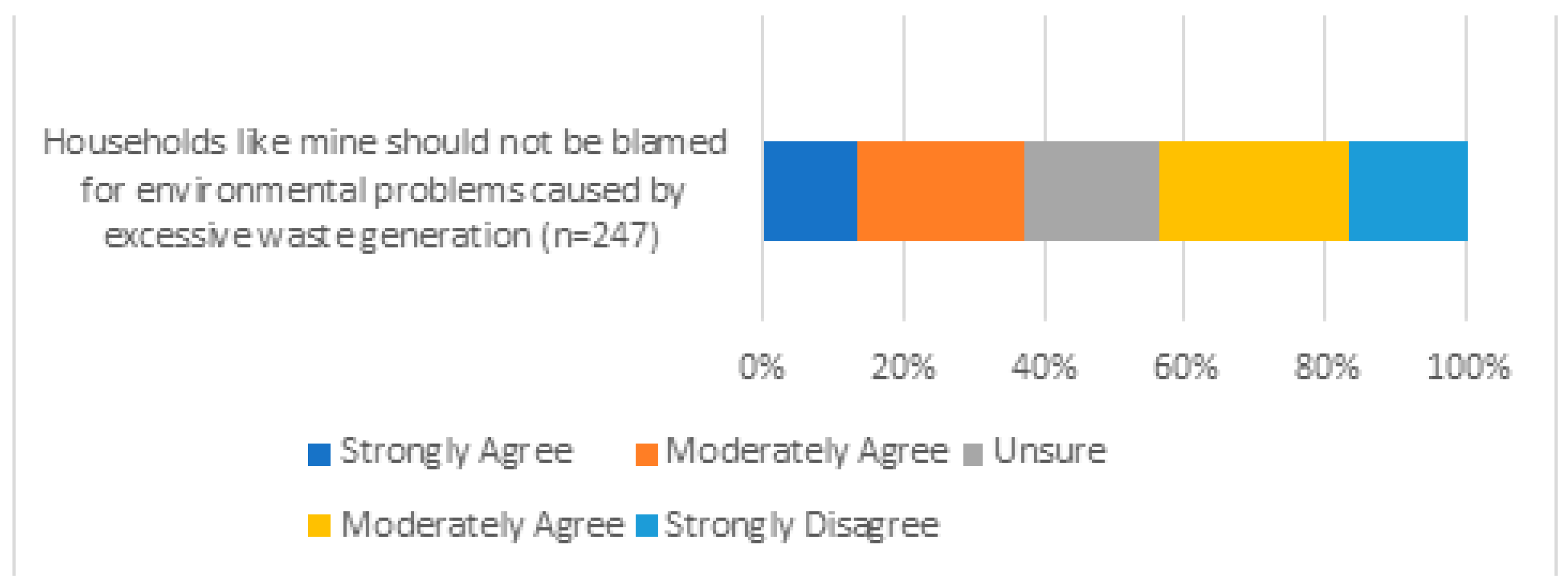
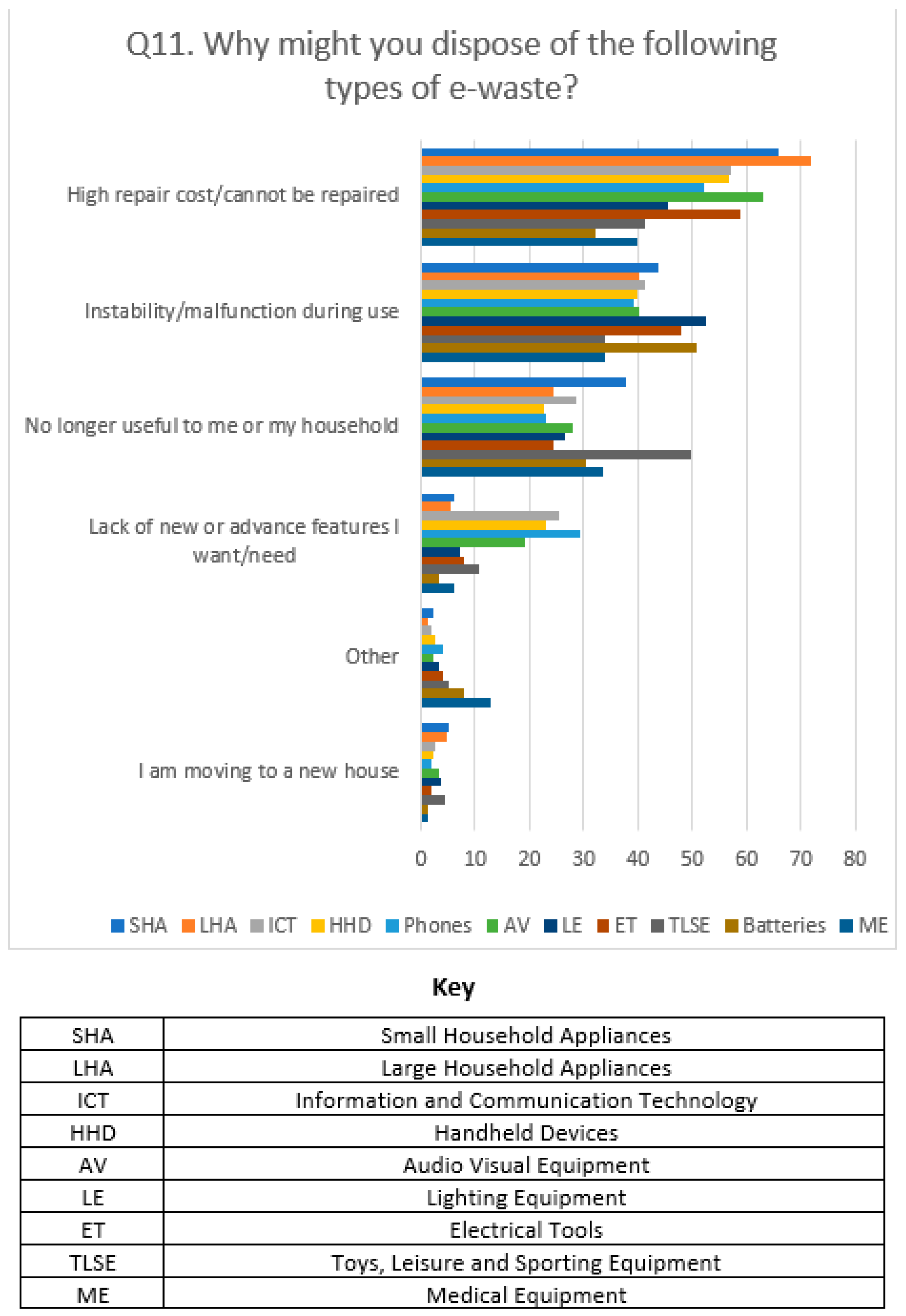
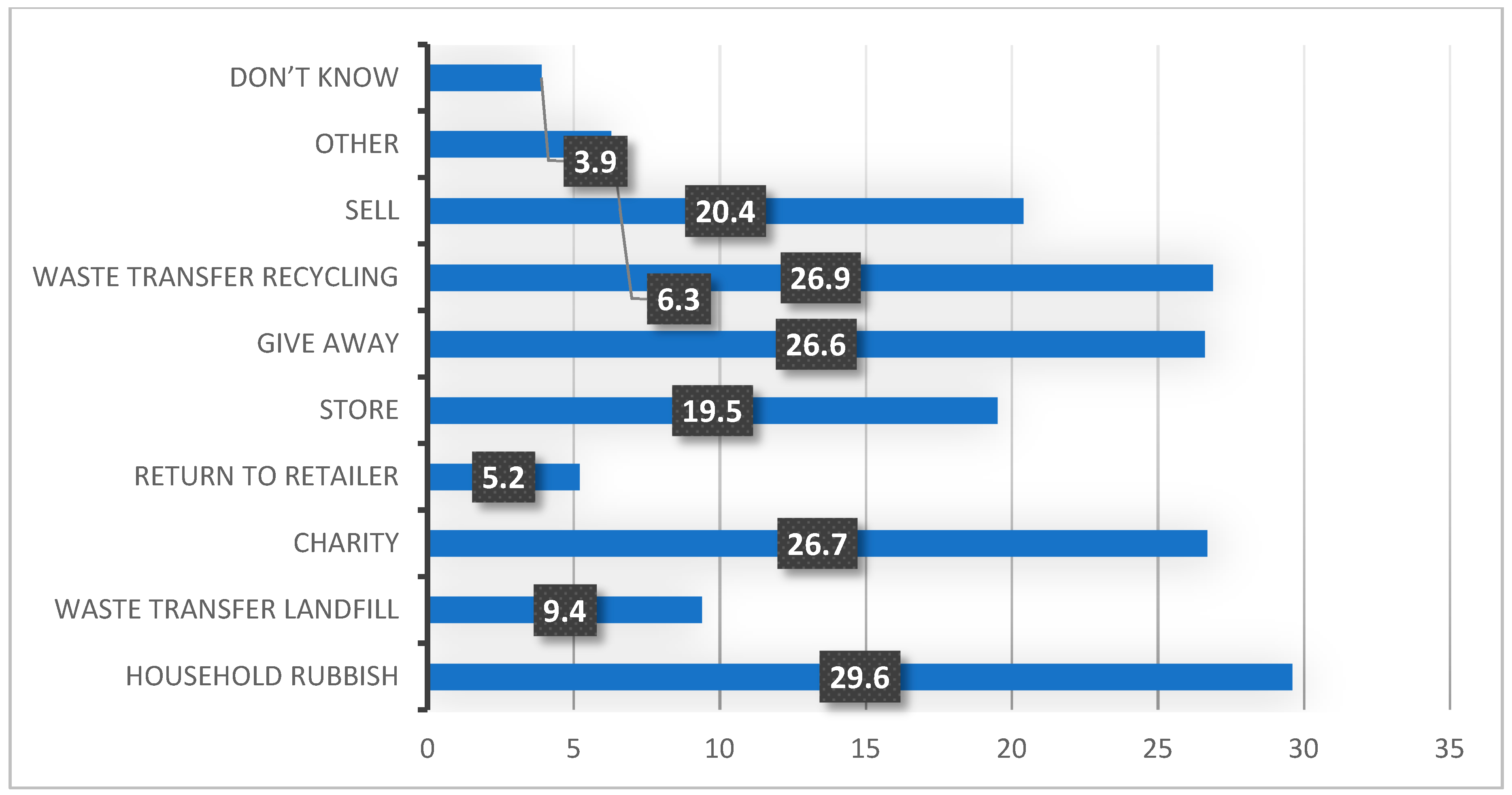
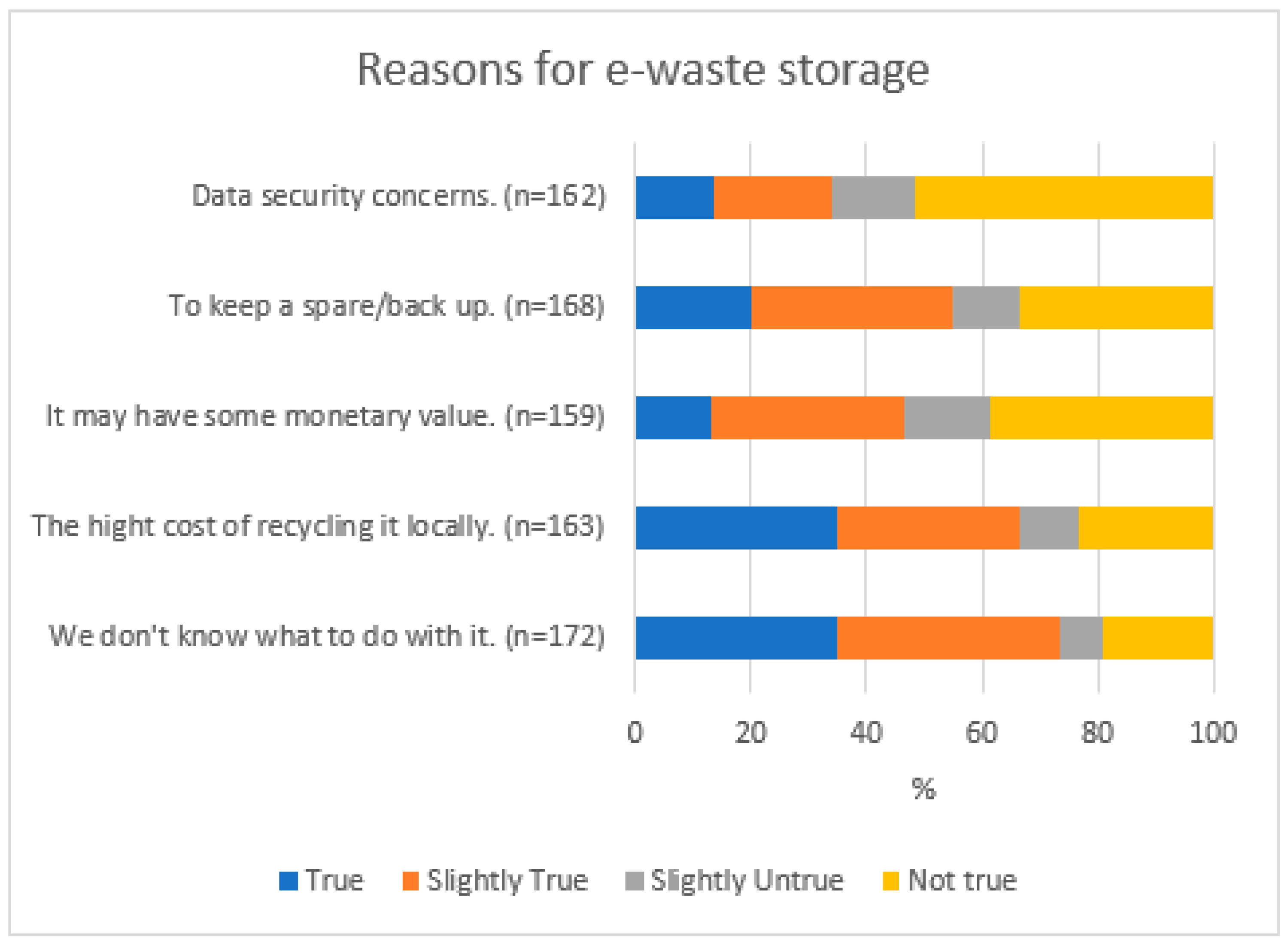
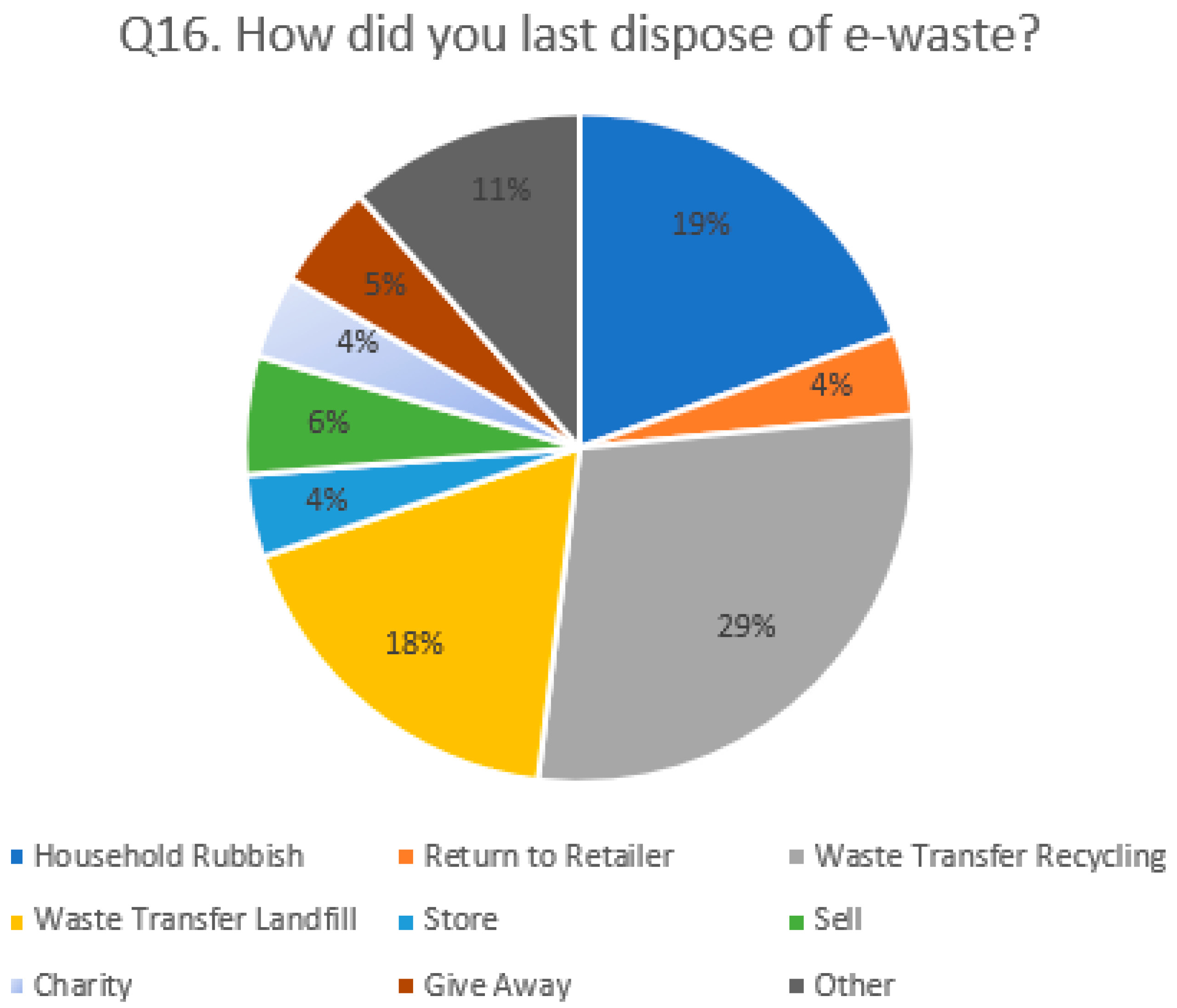
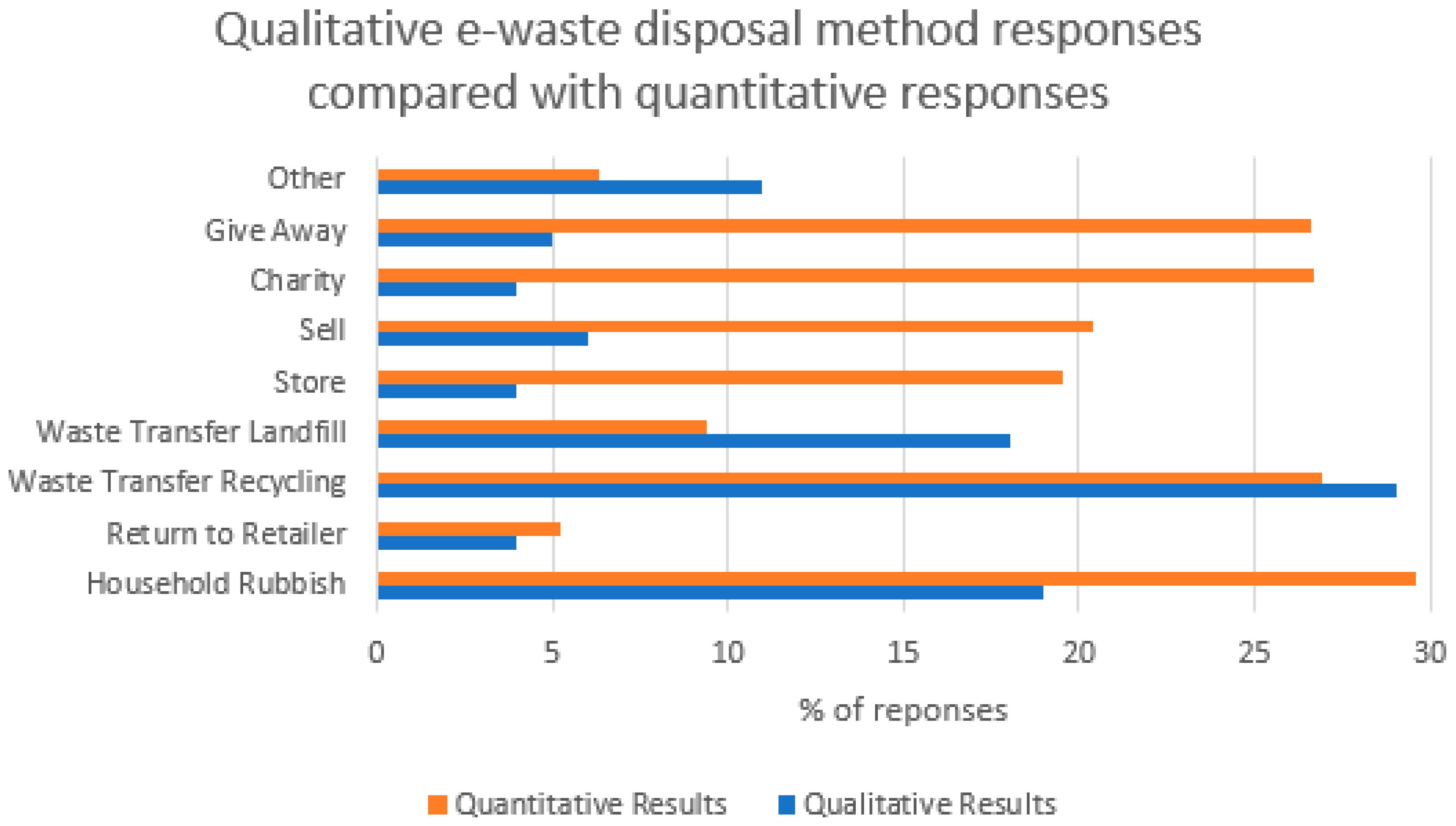
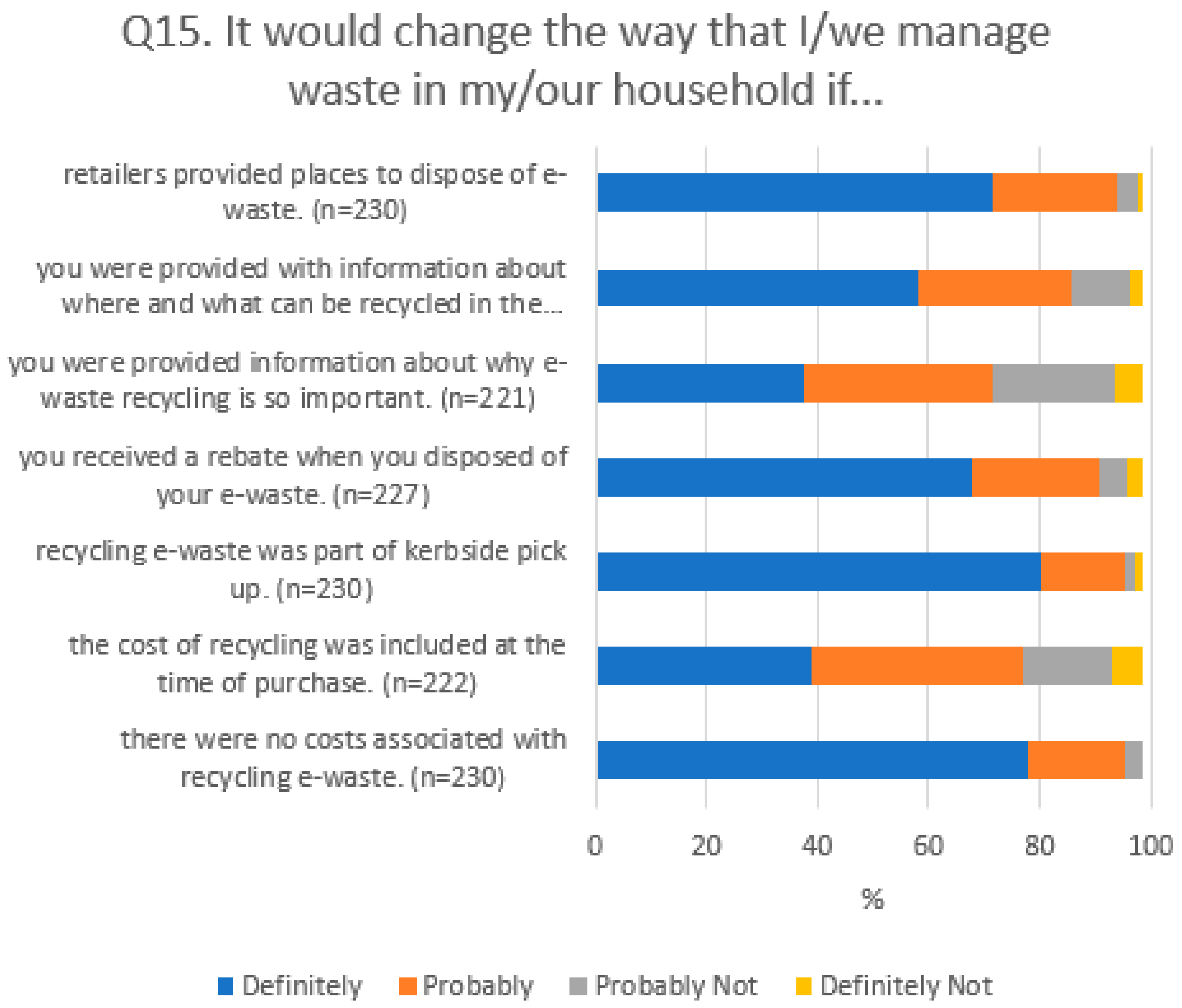
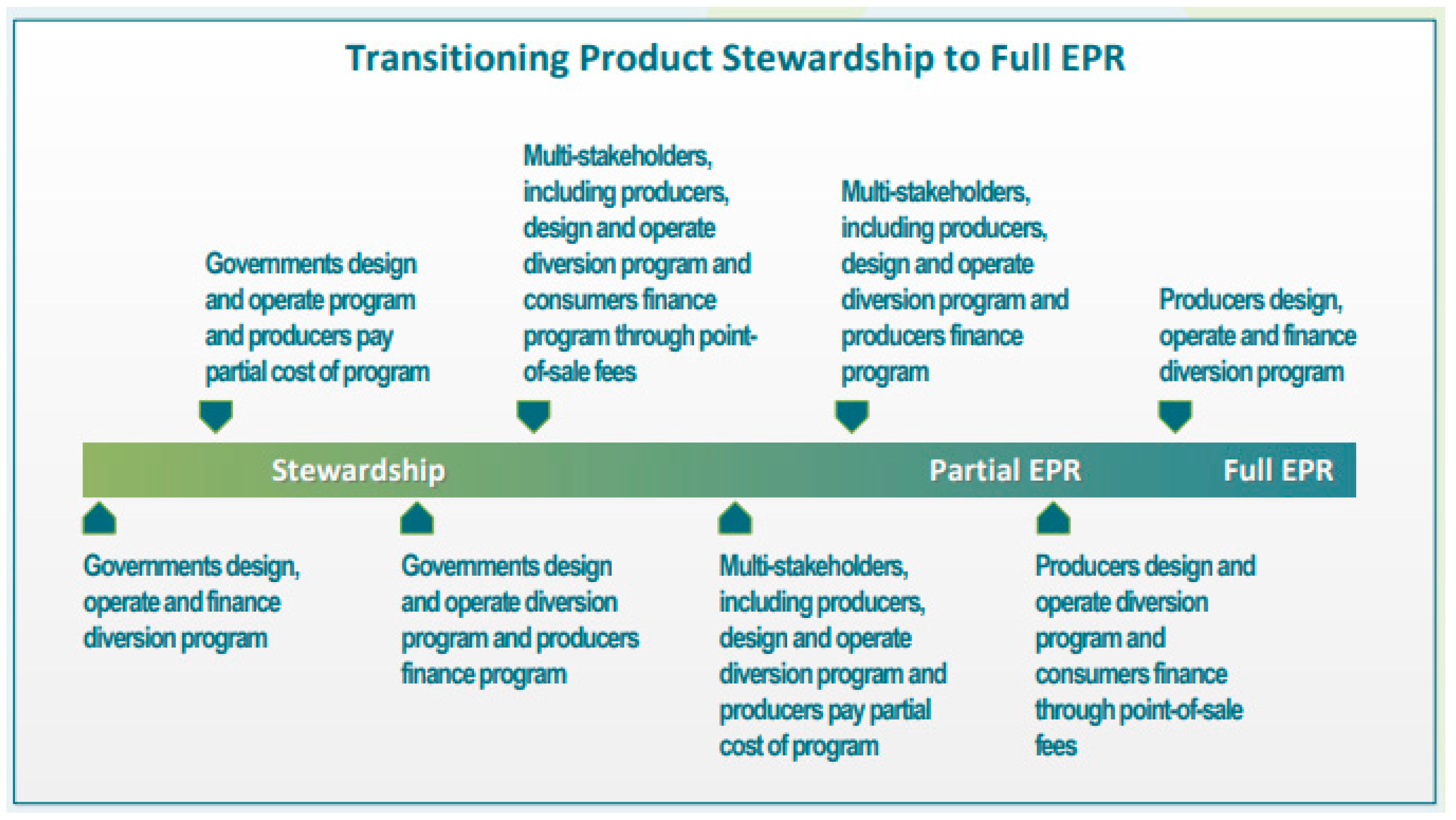
| Type of Disposal | Organisations | Product | Cost |
|---|---|---|---|
| Service Provider Take-Back Scheme | Spark Vodafone 2 Degrees | Smart phones Cell phones | No charge |
| Service Provider Trade-In Scheme | Spark Vodafone 2 Degrees | Some smart phones | Consumer may be given credit or discount |
| Supplier Take-Back Scheme | Dell HP Apple | All products provided by supplier | No charge |
| Supplier Take-Back Scheme | Fisher & Paykel | Refrigerators and freezers Any other e-waste (except computers and TVs) | No charge if collection includes a fridge or freezer |
| Supplier Trade-In Scheme | Dell | Any make of used computer or printer equipment when purchasing new from supplier | No charge |
| Drop-off Recycling | District Council Recycling Schemes | Most e-waste (While WDC collects all forms of e-waste through its municipal schemes, this is not true for all district councils in NZ) | Most products will incur charges |
| Drop-off Recycling | e-Waste Recyclers | Most e-waste | Most products will incur charges |
| Drop-off Recycling | TCF New Zealand Re:Mobile Initiative | Smart phones Cell phones | No charge–contribution made to charity |
| Governmental Initiatives | Key Details |
| Resource Management Act (1991) | Addresses waste management through controls on the environmental effects of waste management facilities through local policy, plans and consent procedures. In 2004, new environmental standards introduced into the Act included improvements in the standards of landfills (e.g., requirements for large landfills to collect and destroy greenhouse gas emissions). |
| Waste Minimisation Act (2008) | Levy imposed on all waste sent to landfill. Clarification of role of territorial authorities regarding waste minimisation. Promotes product stewardship schemes with the opportunity to define priority products for compulsory schemes. Imposes some mandatory waste reporting. The establishment of a Waste Advisory Board. |
| New Zealand Waste Strategy (2010) | Aims to reduce the harmful effects of waste and to improve the efficiency of resource use. |
| Local Government Act (2002) | Includes a requirement for territorial authorities to complete their own Waste Management Plans. |
| Ministry for the Environment Community Environment Fund | Funds projects that support partnerships between parties and increase community-based advice, educational opportunities, and public awareness on environmental issues. |
| Ministry for the Environment Waste Minimisation Fund | Funds projects that promote or achieve waste minimisation. By supporting these projects, the fund increases resource efficiency, reuse, recovery and recycling and decreases waste to landfill. |
| Non-Governmental Initiatives | Key Details |
| New Zealand Product Stewardship Council (2016) | An independent council that supports inclusive government, industry and community engagement around the investigation and implementation of product stewardship and related regulation. |
| eDay New Zealand Trust (2010) | Replaced Computer Access New Zealand Trust (CANZ) (1999). Promotes best practice e-waste collection and recycling. Promotes education initiatives and e-waste awareness. Ran annual e-waste collection days (eDay) in main centres from 2007–2010. |
| The Zero Waste New Zealand Trust (1997) | Promotes zero waste in schools, businesses, councils and households. Acts as a funding manager, distributing funds sources from The Tindall Foundation, Community Employment Group (CEG), and the Sustainable Management Fund to over 300 community groups, schools, etc. |
| Zero Waste Network (2017) | Replaced Community Recycling Network (CRN) (2006). Represents community enterprises focused on zero waste with members from Northland (CBEC–Community Business & Environment Centre) to Southland. |
| Relevant Supranational Waste Directives | Key Details |
| Basel Convention (1989, NZ ratified 1994) | Promotes the reduction of hazardous waste generation and the promotion of environmentally sound management of hazardous wastes, wherever the place of disposal; the restriction of transboundary movements of hazardous materials except where it is perceived to be in accordance with the principles of environmentally sound management; and a regulatory system applying to cases where transboundary movements are permissible. |
| Minimata Convention on Mercury (2013, not yet ratified) | This convention addresses issues relating to the mining, movement, and emissions of mercury. It promotes: the protection of human health and the environment from mercury exposure and Reducing mercury emissions from human activity |
| Convention for the Protection of the Natural Resources and Environment of the South Pacific Region (Noumea Convention) (1986, NZ ratified 1990) | Aims to protect and manage the natural resources and environment of the South Pacific region from polluting and dumping. Also discusses the storage of toxic and hazardous wastes. |
| E-Waste Type | Volume (kg) |
|---|---|
| SCREENS (including CRT and small e-waste) | 14,860 |
| E WASTE (large e-waste items) | 16,860 |
| Disposal Method | Don’t Know | Return to Supplier/Retailer | Other | Waste Transfer Station Mixed with General Waste | Store It | Sell It | Give Away to Friends/Whanau | Donate to Charity | Waste Transfer Station for Recycling | Throw Away with Household Rubbish | ||
|---|---|---|---|---|---|---|---|---|---|---|---|---|
| Category | ||||||||||||
| Small Household Appliances | 2 | 4.8 | 6.4 | 13.1 | 16.7 | 25.9 | 43 | 52.6 | 37.8 | 39 | ||
| Large Household Appliances | 3.2 | 7.6 | 16.4 | 10 | 14.5 | 34.5 | 33.7 | 36.1 | 48.2 | 2 | ||
| ICT | 4 | 6.4 | 6.8 | 10.4 | 29.2 | 24.8 | 31.6 | 31.2 | 44.4 | 14.8 | ||
| Handheld Devices | 7.6 | 6.8 | 7.6 | 6.8 | 32.4 | 26.8 | 36 | 22.8 | 19.2 | 20 | ||
| Phones | 3.2 | 14.5 | 8.4 | 6.4 | 37.3 | 24.1 | 34.9 | 20.8 | 15.3 | 20.1 | ||
| AV Equipment | 5.2 | 5.2 | 3.6 | 10.1 | 26.2 | 29 | 31.5 | 35.1 | 43.5 | 21.8 | ||
| Lighting Equipment | 2 | 2 | 0.8 | 14.4 | 8.8 | 8 | 8.8 | 17.2 | 21.2 | 70.4 | ||
| Electrical Tools | 6.9 | 2.4 | 2.8 | 10.6 | 19.9 | 19.9 | 24.8 | 21.1 | 21.1 | 22.8 | ||
| Toys, Leisure & Sports Equipment | 2 | 0.8 | 0.4 | 10 | 19.1 | 28.3 | 44.2 | 50.6 | 15.1 | 29.1 | ||
| Batteries | 1.2 | 0.8 | 14 | 6 | 6.4 | 0.8 | 0.4 | 0.4 | 21.6 | 68 | ||
| Medical Equipment | 5.7 | 5.7 | 1.6 | 5.7 | 4.5 | 2.4 | 3.2 | 5.3 | 8.5 | 17.8 | ||
| Key | Highest for Category | Highest in Disposal Method | Lowest in Disposal Method | |||||||||
| Number of Items | 1 Item | 2 Items | 3 Items | 4 Items | 5 or More Items | |
|---|---|---|---|---|---|---|
| E-Waste Type | ||||||
| SHA (n = 99) | 38.4 | 32.3 | 15.2 | 2.0 | 12.1 | |
| LHA (n = 62) | 46.8 | 30.6 | 11.3 | 8.1 | 3.2 | |
| ICT (n = 94) | 30.9 | 26.6 | 17.0 | 12.8 | 12.8 | |
| HHD (n = 71) | 43.7 | 35.2 | 8.5 | 8.5 | 4.2 | |
| Phones (n = 124) | 25.8 | 31.5 | 18.5 | 10.5 | 13.7 | |
| AV (n = 65) | 38.5 | 32.3 | 12.3 | 3.1 | 13.8 | |
| LE (n = 47) | 48.9 | 31.9 | 12.8 | 4.3 | 2.1 | |
| ET (n = 53) | 45.3 | 24.5 | 11.3 | 7.5 | 11.3 | |
| TLSE (n = 64) | 28.1 | 20.3 | 14.1 | 6.3 | 31.3 | |
| Batteries (n = 47) | 12.8 | 25.5 | 10.6 | 10.6 | 40.4 | |
| ME (n = 15) | 73.3 | 13.3 | 6.7 | 0.0 | 6.7 | |
| Power cables, cords etc. (n = 93) | 17.2 | 21.5 | 14.0 | 4.3 | 43.0 | |
| Theme | Number of Responses |
|---|---|
| More educational resources required | 17 |
| User pays systems needed | 2 |
| Free drop off/costs are too high | 10 |
| Need for action | 7 |
| Charge at purchase point | 3 |
| Government intervention required | 7 |
| Extended producer responsibility themes | 7 |
| Consume less | 1 |
| Rebates/incentives to recycle required | 3 |
| Issues with current management in Whangarei District | 7 |
| Illegal dumping/fly-tipping | 5 |
| Off topic | 3 |
| TOTAL RESPONSES OVERALL | 67 |
© 2019 by the authors. Licensee MDPI, Basel, Switzerland. This article is an open access article distributed under the terms and conditions of the Creative Commons Attribution (CC BY) license (http://creativecommons.org/licenses/by/4.0/).
Share and Cite
Blake, V.; Farrelly, T.; Hannon, J. Is Voluntary Product Stewardship for E-Waste Working in New Zealand? A Whangarei Case Study. Sustainability 2019, 11, 3063. https://doi.org/10.3390/su11113063
Blake V, Farrelly T, Hannon J. Is Voluntary Product Stewardship for E-Waste Working in New Zealand? A Whangarei Case Study. Sustainability. 2019; 11(11):3063. https://doi.org/10.3390/su11113063
Chicago/Turabian StyleBlake, Vicktoria, Trisia Farrelly, and Jonathon Hannon. 2019. "Is Voluntary Product Stewardship for E-Waste Working in New Zealand? A Whangarei Case Study" Sustainability 11, no. 11: 3063. https://doi.org/10.3390/su11113063
APA StyleBlake, V., Farrelly, T., & Hannon, J. (2019). Is Voluntary Product Stewardship for E-Waste Working in New Zealand? A Whangarei Case Study. Sustainability, 11(11), 3063. https://doi.org/10.3390/su11113063






